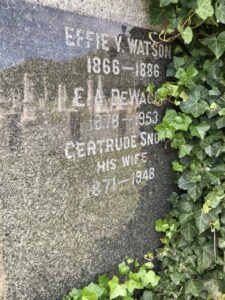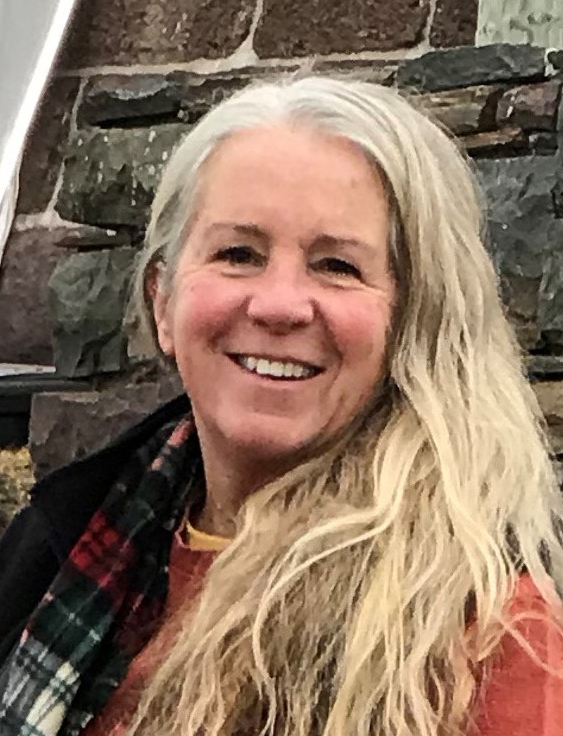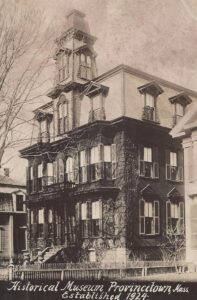 In a recent post about Provincetown’s efforts over the years to reclaim its Pilgrim story, I mentioned a number of initiatives by the Ladies’ Research Club of Provincetown to commemorate Mayflower events. In this year, the quadricentennial of the Mayflower’s First Landing at Provincetown, we owe gratitude to that small club of Provincetown ladies, all of them Mayflower descendants who, a century ago, preserved Pilgrim history for posterity to build upon.
In a recent post about Provincetown’s efforts over the years to reclaim its Pilgrim story, I mentioned a number of initiatives by the Ladies’ Research Club of Provincetown to commemorate Mayflower events. In this year, the quadricentennial of the Mayflower’s First Landing at Provincetown, we owe gratitude to that small club of Provincetown ladies, all of them Mayflower descendants who, a century ago, preserved Pilgrim history for posterity to build upon.
While we now benefit from their scholarship and their sprinkling of the landscape with visual reminders, in truth the impulse of the Ladies’ Research Club members to inscribe the Pilgrim memory on the landscape was not entirely altruistic. Instead, at a time when the nation was undergoing rapid change, industrialization and immigration, the Ladies’ Research Club—an expression of the Colonial Revival Movement—sought to preserve Yankee identity during uncertain times. The marking of “place” was born of a desire to invest significant sites with Yankee cultural heritage at a time when an influx of Portuguese fishermen, mostly from the Azores, was changing the face of Provincetown. Reasserting their identity and presence was as important to the ladies as the tangible public memorials that, they hoped, would extol the town’s history for generations to come.
The marking of “place” was born of a desire to invest significant sites with Yankee cultural heritage at a time when an influx of Portuguese fishermen, mostly from the Azores, was changing the face of Provincetown.
Everyone who reads about Provincetown’s early historic preservation efforts knows that one name, that of Gertrude Snow DeWager, looms as the guiding spirit of those efforts. Born in Provincetown in 1871 to Charles Baxter Snow (1833–1903) and Anna Cook Lancy (1836–1913), Gertrude was educated in the Provincetown schools and was graduated from Dean Academy (formerly Dean Junior College and now Dean College) in Franklin, Massachusetts. She worked as a schoolteacher until her marriage in 1904 to Emmanuel Aloysius DeWager, an Azorean immigrant who graduated from Tufts Dental School in 1901. He became Provincetown’s dentist and devotedly cared for his neighbors for more than fifty years.
During the fall of 1910, Gertrude gathered with Mrs. Grace Hall, Mrs. Mary Sparrow, Mrs. Elizabeth Atwood, Mrs. Anna Young, Mrs. Clara Watson, and Miss Julia Knowles and founded the Ladies’ Research Club. Members researched local records to verify historical facts, and wrote papers about aspects of local history. Their efforts were given a boost and an audience in the local paper, the Advocate, whose publisher Howard Hopkins married Julia Knowles in 1916. With their ambitious dream of eventually opening an historical museum, the group pledged in the short term to mark the landscape with tangible memorials to the Mayflower Pilgrims, to preserve quickly-disappearing relics from the whaling industry, and to restore a number of the oldest graves in the town’s first cemetery at Winthrop and Court Streets (now Winthrop Street Cemetery). In their focus on the old cemetery, one of Provincetown’s lost stories began to re-emerge.
It had long been said that an older burial ground, predating the Winthrop Street Cemetery (whose earliest recorded headstone dated to 1711), had existed near the corner of Bradford Street and Franklin Street, the town’s oldest street, named for Benjamin Franklin. Legend had told that the Pilgrims’ first wash day took place along the shore at the foot of Franklin Street. During the construction of Bradford Street in 1872, the burial ground had been destroyed. At the time, the oldest residents of Provincetown remembered that four small, black stones, sent from England, had marked the graves of the four Mayflower passengers—Edward Thomson, Jasper More, Dorothy (May) Bradford, and James Chilton— who had died 14–18 December 1620, while the ship was anchored at Provincetown. (A fifth passenger, William Butten, had died at sea on November 16.) Mrs. DeWager’s mother, Anna Cook Lancy, had told her daughter that she saw the small stones every day on her walk to school in the 1840s.
Other residents remembered that when Bradford Street was cut through, a number of stones from the earlier burial ground had been relocated to the Winthrop Street Cemetery. When a search for the Pilgrim headstones proved futile, the Ladies’ Research Club members had a tablet, inscribed with the names of the four passengers, installed for the Pilgrim Tercentenary in 1920.
In 1938, provoked by a writer who made the claim that Provincetown had not been visited by the Mayflower, the story of the Pilgrim graves was revived in an effort to support the First Landing of the Pilgrims at Provincetown. A number of Provincetown residents proposed to dig for the graves on the grounds of a house at 16 Bradford Street.(Interestingly, there is currently a real estate listing for the 16 Bradford Street house, built in 1885.) The owners of the property, Mr. and Mrs. Joseph Santos, refused to allow the excavation and though the Provincetown newspaper noted that many in Provincetown believed that the unearthing of the stones “would be more precious than the Rock on the other side of the bay,” no further discussion seems to have taken place nor efforts made to find the stones.
Meanwhile, in 1924 the Ladies’ Research Club had realized their dream of opening an historical museum. For a number of years, the ladies had been collecting interesting artifacts and displaying them temporarily in Town Hall, but in 1923 the Second Empire mansion that belonged to Benjamin Lancy III (1847–1923), Gertrude DeWager’s uncle, became available upon his death. A wealthy and eccentric lawyer, and a lumber and coal merchant, Lancy had made a small fortune in real estate buying up properties in Boston and Provincetown and paying off the back taxes. His house had stood empty for months after he had been taken to a sanitarium in 1922. Built in 1874 with three stories, sixteen rooms, and a “Boston brownstone” finish, the Lancy house was the grandest and most ornate (some said ostentatious) in town, standing out amidst Provincetown’s modest Capes and even its more sophisticated Colonials. With its many fine antiques and unique architectural elements the house was, noted the ladies, a museum in its own right and certainly an appropriate place to house the town’s growing collection of antiquities. Bequeathed to Benjamin Lancy IV, the younger Lancy negotiated the sale after a public appeal by the Ladies’ Research Club members raised the necessary funds to purchase the building and equip the rooms. The whole town expressed its confidence in the plan. The Provincetown Historical Museum was born. A small ad encouraging visitors singled out the reconstructed Provincetown colonial kitchen, a collection of Sandwich glass, old documents, MacMillan’s Arctic exhibit, whaling implements, Peregrine White’s signature, a fascinating large, fully furnished doll house and relics of every American war … all for an admission fee of twenty-five cents, plus five cents tax!
With the passage of time, membership in the Ladies’ Research Club—Mayflower ancestry being a prerequisite—began to dwindle. In January 1948, Gertrude DeWager, the museum’s guiding spirit, passed away at the age of seventy-six. By 1956, only one charter member was living. Sixty-nine members had died and the active membership of the Research Club had been reduced from more than one hundred to forty-four, most living away from Provincetown. A decision was made to turn the museum over to the Cape Cod Pilgrim Memorial Association, whose members had built the Pilgrim Monument (1907–10) to commemorate the Pilgrims’ First Landing at Provincetown. In June 1956, the deed to the Historical Museum was conveyed. At the start of the 1962 summer season, a new museum opened on the grounds of the Pilgrim Monument, welcoming 85,000 visitors that first year.
Many items from the core of the early collection are still on display in the museum atop High Pole Hill. I visit often and as I walk through the rooms, through the four hundred-year history of Provincetown, I can’t help but admire the foresight of those original seven women who toiled for years, exhaustively researching and collecting, while organizing suppers, lawn parties, and cake sales to raise the capital to make a dream come true. Within six years of throwing open the doors they had burned the mortgage on the Lancy mansion, had increased their membership to seventy-six women, and had welcomed countless visitors to Provincetown’s own time capsule of bygone days.
At a time when too much history was being lost and removed from Provincetown by antique dealers and collectors, the ladies understood how important it was to preserve the past, understood that their town was the sum of its history and that its artifacts, collectively, helped to tell the complete and unvarnished story of the town’s evolution. They grasped, too, the magnitude of the 1620 moment and, now, 400 years later, we are pausing again to reflect on what that moment has meant to American history.
Share this:

About Amy Whorf McGuiggan
Amy Whorf McGuiggan recently published Finding Emma: My Search For the Family My Grandfather Never Knew; she is also the author of My Provincetown: Memories of a Cape Cod Childhood; Christmas in New England; and Take Me Out to the Ball Game: The Story of the Sensational Baseball Song. Past projects have included curating, researching, and writing the exhibition Forgotten Port: Provincetown’s Whaling Heritage (for the Pilgrim Monument and Provincetown Museum) and Albert Edel: Moments in Time, Pictures of Place (for the Provincetown Art Association and Museum).View all posts by Amy Whorf McGuiggan →
